CATCH My Breath
CATCH My Breath
Evidence-Based Youth Vaping Prevention Program

Empowering youth to be vape free.
CATCH My Breath’s peer-led teaching approach empowers students with the knowledge and skills needed to make informed decisions about e-cigarettes and resist social pressures to vape. Informed by tobacco youth prevention researchers and practitioners, years of real world implementation, and a youth advisory board, it is the only school-based vaping prevention program proven to reduce the likelihood of vaping among youth.


Youth informed.
Parents & Community
Note: If you have technical issues playing the parent/community videos in this section, try our YouTube playlist.
Program Information for Parents
 Introduction Letter to Parents
Introduction Letter to Parents
English version / Spanish version This letter is intended for parents whose children are going to participate in the CATCH My Breath program. (Teachers: This is the same letter mentioned in Session 0.)
 Parent Information Handout
Parent Information Handout
English version / Spanish version
This handout covers general program information and answers questions like “What will students learn?” and “Why is E-cigarette education needed?” If you would like more information about the program or to bring the program to your child’s school, please email [email protected].
Parent Toolkit Grades 5-12
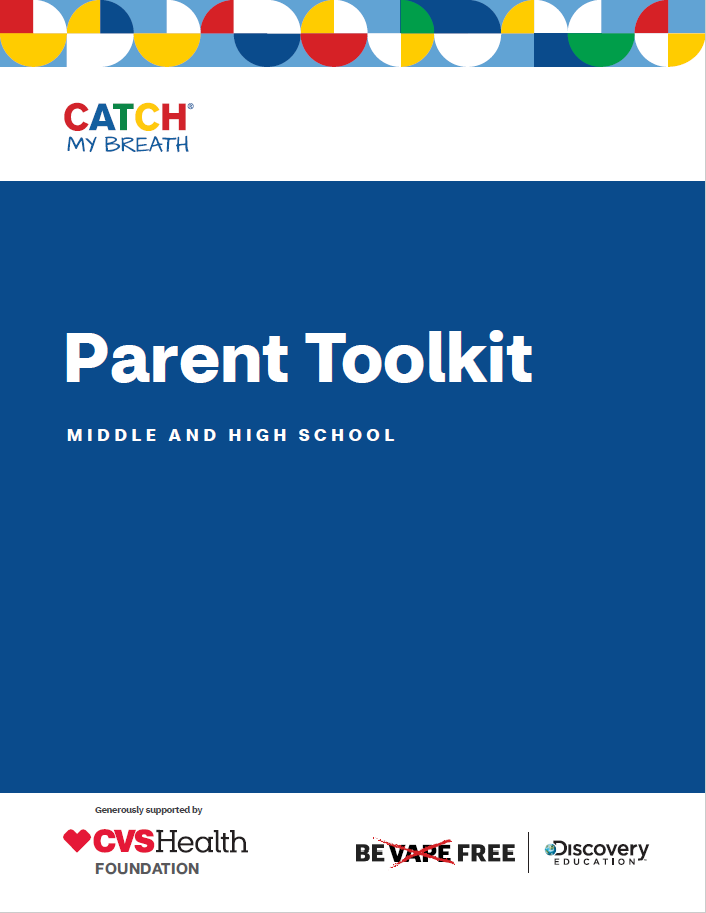 Parent Toolkit Grades 5-12
Parent Toolkit Grades 5-12
English version / Spanish version
This toolkit is a way for parents to learn more about the vaping epidemic, gauge their child’s risk of trying e-cigarettes, and find the best strategy for them to talk to their child about e-cigarettes.
Parent Toolkit Videos
Video One: The Youth Vaping Epidemic
Youth vaping is on the rise and parents need to be equipped with e-cigarette knowledge. This video covers four facts about youth vaping and how your child might be impacted by the epidemic.
Video Two: Strategies to Support Your Child’s Healthy Decisions
Checking in with your child can help them make healthy decisions, including the decision to not use e-cigarettes. In this video, you will learn simple, yet effective ways to check in with your child and support healthy decisions.
Video Three: Could Your Child be Vaping?
E-cigarettes can sometimes be hard to spot, making your job as a parent more challenging. In this video, you will learn how to identify e-cigarette and vaping products. You will also learn of common signs of vaping and nicotine addiction.
Video Four: 4 Reasons to Talk to Your Child about E-Cigarettes Today
Talking with your child about smoking and vaping can be difficult, and some parents avoid the discussion altogether. In this video, you will learn the important reasons why you should talk with your child about vaping.
Video Five: How to Talk to Your Child about E-Cigarettes
Talking to your child about smoking and vaping doesn’t have to be overwhelming. In this video, you will learn four tips to effectively talk with your child about vaping.
Parent Toolkit Grades K-4
Parent Toolkit Grades K-4
It’s vital to start early when it comes to educating parents and caregivers about the dangers of vaping and the exposure that even elementary students have to vaping and misinformation about it. Our parent education resources for parents of younger children include an informational video, along with a fact sheet and parent-child activity, both of which can be shared digitally or printed and shared as handouts.
Videos
Fact Sheet
English Version / Spanish Version
Parent-Child Activity
Parent / Community Presentations
Help fellow parents or community members stay informed about the youth vaping epidemic and prevention efforts by hosting an educational presentation. This presentation provides basic information about e-cigarettes & vaping products, the extent of the youth vaping epidemic, short- and long-term effects of vaping, and explains how to engage in your community, including how CATCH My Breath can help schools.
Presentation Options
- Pre-recorded video presentation (below)
- Self-serve, downloadable presentation slides (includes slide-by-slide scripting in the notes section)
- Live webinar delivered by a CATCH My Breath staff member (available on a limited basis, please email [email protected] for information)
Parent / Community Presentation Video (English)
Parent / Community Presentation Video (Spanish)
E-Cigarette Background Information
What is an E-cigarette?
E-cigarettes are a type of electronic nicotine delivery system (ENDS) and their appearance can vary from resembling a conventional cigarette to a USB flash drive. They use a nicotine liquid often called e-liquid or e-juice, which is often sweet or candy flavored, to deliver nicotine to the body. While they were developed as a means to help smokers quit, they have rapidly become the new means of nicotine addiction, especially among young people. The following video explains e-cigarettes in detail.
What does an E-cigarette look like?
E-cigarettes can take on many different shapes and forms and they can vary in name. Today, E-cigarettes include brands such as JUUL, Blu,Vapor Fi, PHIX,Suorin Air, My Jet, and PULSE. Below you can see examples of (1) disposable e-cigarettes, (2) reusable “tanks” or “mods” (3) Suorin drops, (4) and JUULs. Although there are a lot of e-cigarette options available, JUUL is currently the most popular e-cigarette in the United States with roughly 75% of the market share.
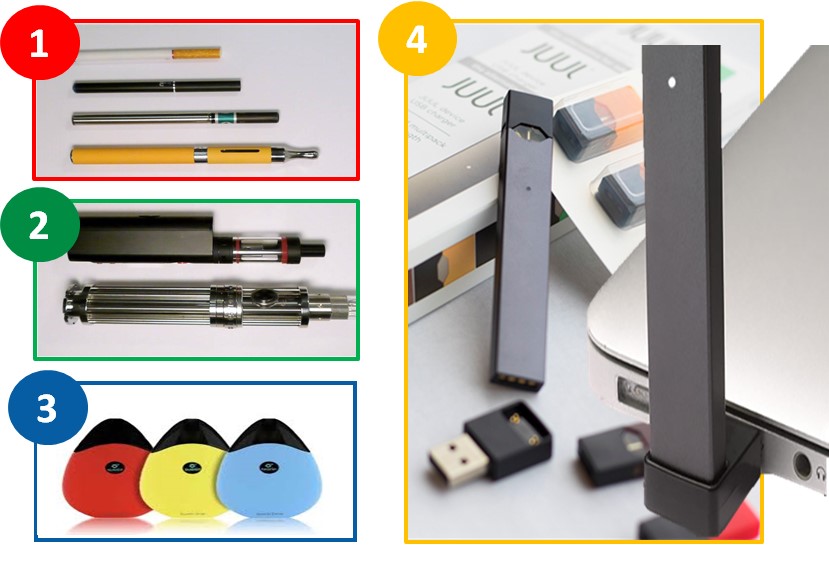
How common is E-cigarette use?
As of 2020, 19.6% of high school students and 4.7% of middle school students across the U.S. have used E-cigarettes in the past 30 days. This data points to the fact that large numbers of American children will become addicted to nicotine and are at risk for becoming a regular tobacco user.
CDC: 2020 National Youth Tobacco Survey
How harmful are e-cigarettes?
- E-cigarettes are a source of extremely high doses of ultrafine particles in the human respiratory system. These particles have been linked to cardiovascular disease.
- Nicotine is much more addictive to the immature teen brain compared to the developed adult brain.
- Even a little nicotine can lead to ADHD-like symptoms and compulsive behavior, which can contribute to classroom behavior problems.
- There is some evidence that nicotine primes the brain for other drug addictions.
- Nicotine is extremely harmful to the developing fetus. There is no known safe level of nicotine exposure in utero.
- Drinking nicotine in E-juice is harmful and possibly fatal for babies and toddlers.
- Nicotine overdose symptoms include rapid heart rate, nausea, elevated blood pressure, vomiting, diarrhea, dizziness, convulsion, and potentially seizure and death.
- The process of heating the nicotine solution produces aldehyde, acetaldehyde, formaldehyde, and acrolein, which are known carcinogens.
- The glycerin/propylene glycol and 8,000+ flavoring chemicals in e-cigarettes have only been approved for ingestion (eating). It is not recommended by the manufacturers that these chemicals be inhaled, as they have not been widely tested for their potential sensitizing, toxic, or irritating characteristics.
- Many E-liquids are custom-mixed by individuals at home, increasing the potential for additional health risks to E-cigarette users. Even commercial E-liquids are produced with unknown manufacturing procedures, packaging materials, and purity standards.
Addicted Early
This 4-minute video follows two friends, Mari and Jake before school as they discuss a class project and Jake’s new obsession with his vape.
PSA Videos
Additional Resources
These resources give more detailed information about e-cigarettes, the youth vaping epidemic, and other related topics.
- CDC: E-cigarette, or Vaping Product Visual Dictionary
- FDA Raises Federal Minimum Age of Sale of Tobacco Products to 21
- FDA: Limited Flavor Ban Enforcement Policy
- CDC: E-cigarettes and Youth: What Parents Need to Know
- Surgeon General: The Call to Action on E-cigarette Use Among Youth and Young Adults
- American Lung Association: E-cigarettes, “Vapes”, and JUULs: What Parents Should Know
- American Cancer Society: Questions and Answers about E-cigarettes for Parents
- American Cancer Society: What You Need to Know about E-cigarettes: For Middle and High School Students
- Science News for Students: Concerns Explode Over New Health Risks of Vaping
- Campaign for Tobacco Free Kids: Don’t Trust JUUL
- Campaign for Tobacco Free Kids: Big Tobacco is Back
- Public Health Law Center: U.S.
E-Cigarette Regulations – 50 State Review - Truth Initiative: Behind the explosive growth of JUUL
- Truth Initiative: Vaping Lingo Dictionary: A guide to popular terms and devices
- UThealth: Quick Facts About JUUL, The High Nicotine Product Hiding In Plain Sight
- Fox 32 Chicago: Vape pen explodes, shattering teenager’s jaw and knocking out some teeth
About the Program

Proven Effective
CATCH My Breath is an evidence-based youth vaping prevention program for grades 5-12 that has been proven to substantially reduce students’ likelihood of vaping. The vape education program’s effectiveness was published in a peer-reviewed journal and the program is listed in SAMHSA’s Evidence-Based Resource Guide Series.

Robust Program & Resources
Developed by The University of Texas Health Science Center at Houston (UTHealth) School of Public Health, the vape education program includes grade-level specific and health education standards-aligned classroom curriculum alongside a variety of engaging supplemental materials including STEM/Humanities/PE extensions, self-paced modules, and virtual field trips.

Training & Support
CATCH Global Foundation provides teacher and health educator trainings that help ensure facilitators are effective in the vape education program delivery. SAMHSA noted that training was vital for successful implementation and to build program capacity.
Program Contents
Core Program
CATCH My Breath is an evidence-based youth vaping prevention program for grades 5-12 that has been proven to substantially reduce students’ likelihood of vaping.
Classroom Sessions
The CATCH My Breath Program (grades 5, 6, 7-8, and 9-12) consists of 4 unique lessons for each grade group, that are approximately 35 minutes each. Each session includes a lesson plan with learner outcomes, a detailed outline of directions, and all materials including corresponding PowerPoint presentations.
Classroom Session Overviews
Grades 5 – 8
Session 1: Consequences of using e-cigarettes
- Identify negative consequences of e-cigarette use.
- Describe the health hazards associated with e-cigarette use.
- Analyze the safety of flavor chemicals and their role in e-cigarette marketing.
- Analyze basic ingredients in e-liquid.
Session 2: Making our own choices
- Identify the percentage of e-cigarette users in middle school and high school and describe nonsmokers as the majority.
- Describe the harmful consequences of e-cigarette use.
- Identify reasons why teens may begin using e-cigarettes.
- Identify positive alternatives to using e-cigarettes.
- Develop, practice and demonstrate refusal skills and smart exit strategies.
- Interview an adult regarding tough choices and tobacco use.
Session 3: Don’t let them lie and win
- Recognize situations and places that may be high-risk for being offered an e-cigarette.
- Discover the amount of money the tobacco and e-cigarette industry spends on advertising its products.
- Describe the role of advertising dollars in e-cigarette use.
- Recognize indirect and direct advertising strategies.
- Recognize the covert methods that the tobacco and e-cigarette industry uses to attract new e-cigarette users.
- Analyze some of the propaganda techniques tobacco and e-cigarette companies use to sell their brand of e-cigarette.
- Develop a messaging project (warning label) that addresses misconceptions and promotes the benefits of being e-cigarette-free.
Session 4: Your Life. Your Choice.
- Review the covert methods that the tobacco and e-cigarette industry uses to attract new e-cigarette users.
- Develop and present a messaging project (warning label) that addresses misconceptions and promotes the benefits of being e-cigarette-free.
- Make a personal goal regarding e-cigarette use.
9th – 12th Grades
Session 1: Designed for Addiction
- Understand the highly-addictive nature of nicotine.
- Describe the health hazards associated with e-cigarette use.
- Identify the health and social consequences of e-cigarette use.
Session 2: What could go wrong?
- Identify existing knowledge or perceptions of e-cigarettes.
- Dispel misconceptions about e-cigarettes.
- Synthesize information about the health and social consequences of using tobacco products such as e-cigarettes.
- Discover ways to quit using tobacco products (including e-cigarettes) and support peers who want to quit by offering encouragement and referring cessation resources to them.
Session 3: Co-create & hack the system
- Learn about laws, rules and regulations regarding tobacco and e-cigarettes.
- Discuss the reason behind such rules and how it applies to youth.
- Understand that they can participate actively in such policy making.
Session 4: Take Control of Your Life
- Learn to create laws and rules regarding tobacco and e-cigarette.
- Learn to communicate policies to governing agencies.
Training
CATCH Global Foundation provides teacher and health educator trainings that help ensure facilitators are effective in program delivery. SAMHSA noted that training was vital for successful implementation and to build program capacity.
Program Supplements
These supplements are optional but designed to enhance the core CATCH My Breath vape education program.
Video Lessons
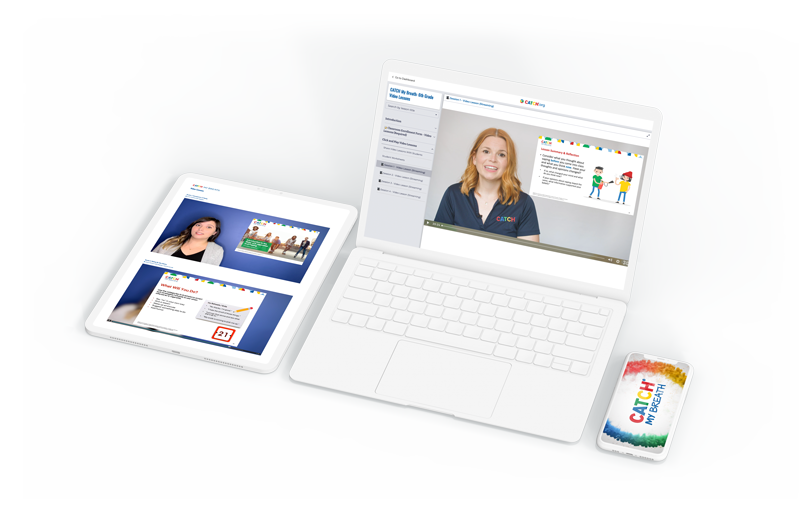
Available as a paid add-on option, these engaging video lessons include on-screen slides, activity prompts, and companion worksheets.
Designed for synchronous or asynchronous learning environments, we provide two delivery formats to give teachers optimal flexibility.
STEM & Humanities Supplements
Supplementary lesson bundles are designed to be interdisciplinary and can be incorporated into everyday classroom curriculum. These supplements were developed in partnership with Discovery Education as part of the Be Vape Free initiative.
“Risks of E-Cigarettes”
Science, Health • Upper Elementary
In the Supplemental Science Bundle, students will dive into important questions such as, “what parts of the brain and body are affected by e-cigarette use” and “what harmful and toxic chemicals can be found in e-cigarettes.”
“E-Cigarette Laws & My Community”
Social Studies, English-Language Arts • Upper Elementary
In the Supplemental Humanities Bundle, students will explore how states are addressing the vaping crisis through legislation around the sale, purchase, and use of e-cigarettes. Students will investigate the evolution of their state’s laws & the purposes behind enacting those laws.
“Refuse to Lose: E-Cigarette Realities”
Science, Health • Middle School
In the Supplemental Science Bundle, students will learn that e-cigarettes produce aerosols composed of potentially harmful chemicals, including nicotine, and about the damage that nicotine can do to the brain and body.
“Take Charge of your Health: The Truth About E-Cigarettes”
Social Studies, English-Language Arts • Middle School
In the Supplemental Humanities Bundle, students will investigate credible and non-credible sources of health information to learn how to identify valid sources of information in order to make healthy decisions for themselves.
PE Supplement
The PE supplement is an active addition to CATCH My Breath that was designed to reinforce learning objectives in an active physical education setting. The supplement is available in two versions: Grades 5-8 and Grades 9-12.
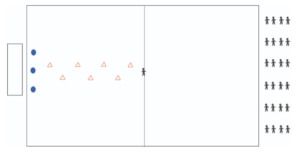
Virtual Field Trips
The Virtual Field Trips (VFTs) are engaging video resources that allow educators to take their students to unique places, meet interesting people, and have immersive and educational experiences – all without leaving the classroom! Developed in partnership with Discovery Education as part of the Be Vape Free initiative, these VFTs are a great way to kickoff Red Ribbon Week (October), Tobacco Awareness Month (November), or the start of the CATCH My Breath program at your campus.
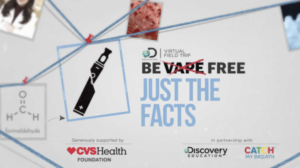
Just The Facts: A Be Vape Free Virtual Field Trip
Get ready for an exciting virtual detective story that lets your students become E-cigarette Sleuths cracking the case of vaping once and for all! Introduce students to an array of amazing special guests, and dive into the science of addiction by tracking vape aerosol on its nefarious journey from the e-cigarette all the way into the lungs, bloodstream, and brain.
Witness the thrilling conclusion of the great vape mystery by watching today! You can get your Vape Investigators excited both before and after watching the Virtual Field Trip with the companion Educator Guide.
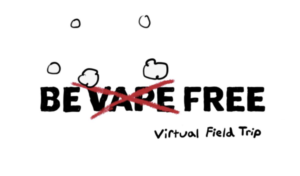
Clearing The Air: A Be Vape Free Virtual Field Trip
Join us for a real-world virtual learning opportunity to get the facts on the vaping epidemic. Students will gain powerful insights as several teenagers share their firsthand experiences of successfully avoiding e-cigarettes, learn how to think critically about everyday influences like advertising and social media, pick up effective refusal skills and debunk common myths with a health professional. Be sure to share this important virtual learning experience with your students, as those who use e-cigarettes are at increased risk of complications from respiratory illnesses like COVID-19!
Cannabis Vaping Lessons
In the supplemental Cannabis Vaping lessons, students learn about “Fact vs. Fiction” when it comes to vaping marijuana.
Self-Paced Modules
Self-paced modules are designed to be done independently by students, but not as a substitute for the core program. The engaging and interactive content is accessed directly by students via the web. These modules were developed in partnership with Discovery Education as part of the Be Vape Free initiative.

Elementary School Self-Paced Module Video Series
Encourage students to investigate the truth and consequences of vaping and e-cigarette use. Educators may view the videos together with their students using the standards-aligned lesson plans and educator guide or assign it for students to explore independently.

Middle School Self-Paced Module: Vaping Risks Revealed
Can you get addicted to vaping? Does using e-cigarettes affect your brain? Students will have the opportunity to learn about the effects of vaping as well as strategies for making safe choices.
Instructional Details
Learning Outcomes
The overall goal of CATCH My Breath is to prevent the initiation of e-cigarette use among preteen and teen adolescents. The program is designed to help students:
- Discover that non-use of e-cigarettes is the norm for adolescents
- Identify reasons why young people might start using e-cigarettes
- Recognize the subtle, and not so subtle, messages in e-cigarette advertising
- Practice skills for resisting peer pressure and advertising pressure to use e-cigarettes
- Decide on their personal reasons not to use e-cigarettes and set goals for future non-use
The intended outcomes are to ensure that students will:
- Resist their own curiosity, peer and advertising pressure to experiment with e-cigarettes
- Understand that e-cigarettes are addictive, unhealthy, and not as popular as they think
- Influence friends and peers not to use e-cigarettes
Educational Strategies
- Social & Emotional Learning (SEL)
- Peer-facilitated cooperative learning groups*
- Large-group discussions
- Analysis of mass media
- Goal setting
*The use of peer group facilitators ensures cultural appropriateness for students across socioeconomic groups, cultures, ethnicities, and regions in the United States. In addition, same-age peers are more likely than teachers or outsiders to speak the same “peer language” and have the same perspective as the students.
CATCH My Breath activities were designed to influence social and psychological factors related to youth e-cigarette use by:
- Disrupting the norm held by youth that most teens smoke e-cigarettes
- Developing skills to resist peer pressure and advertising pressure to use e-cigarettes
- Understanding how advertising is designed to undermine credible health information
- Creating favorable non-smoking attitudes and beliefs about e-cigarettes
Standards & Alignments
National Academic Standards
CDC National Academic Standard for Health Education
- Standard 1 Students will comprehend concepts related to health promotion and disease prevention to enhance health.
- Standard 2 Students will analyze the influence of family, peers, culture, media, technology, and other factors on health behaviors.
- Standard 3 Students will demonstrate the ability to access valid information, products, and services to enhance health.
- Standard 4 Students will demonstrate the ability to use interpersonal communication skills to enhance health and avoid or reduce health risks.
- Standard 5 Students will demonstrate the ability to use decision-making skills to enhance health.
- Standard 6 Students will demonstrate the ability to use goal-setting skills to enhance health.
- Standard 7 Students will demonstrate the ability to practice health-enhancing behaviors and avoid or reduce health risks.
- Standard 8 Students will demonstrate the ability to advocate for personal, family, and community health.
English/Language Arts Standards (Grade 6-8)
Listening and Speaking
- Plays a variety of roles in group discussion
- Asks questions to seek elaboration and clarification of ideas
- Conveys a clear main point when speaking to others and stays on the topic being discussed
- Makes oral presentations to the class
Viewing Media (Advertising) (Grades 6-8)
- Knows that people with special interests and expectations are the target audience for particular messages or products in visual media
- Understands techniques used in visual media to influence or appeal to a particular audience
Life Skills (Grades 6-8)
Thinking and Reasoning
- Identifies alternative courses of action and predicts likely consequences of each
- Examines alternatives for resolving local problems and compares the possible consequences of each
- Identifies situations in the community and in one’s personal life in which a decision is required
- Predicts the consequences of selecting each alternative
- Takes action to implement the decision, when appropriate
Working with Others (Grades K-12)
- Contributes to the overall effort of a group
- Uses conflict-resolution techniques
- Displays effective interpersonal relationship skills
- Demonstrates leadership skills (e.g., peer group facilitators)
Self-regulation (Grades K-12)
- Sets and manages goals
- Considers risks
- Demonstrates perseverance
- Maintains a healthy self-concept
- Restrains impulsivity
Common Core Standards
Speaking and Listening: Comprehension and Collaboration (Grade 5)
CCSS.ELA-LITERACY.SL.5.1
Engage effectively in a range of collaborative discussions (one-on-one, in groups, and teacher-led) with diverse partners on grade 5 topics and texts, building on others’ ideas and expressing their own clearly.
CCSS.ELA-LITERACY.SL.5.1.A
Come to discussions prepared, having read or studied required material; explicitly draw on that preparation and other information known about the topic to explore ideas under discussion.
CCSS.ELA-LITERACY.SL.5.1.B
Follow agreed-upon rules for discussions and carry out assigned roles.
CCSS.ELA-LITERACY.SL.5.1.C
Pose and respond to specific questions by making comments that contribute to the discussion and elaborate on the remarks of others.
CCSS.ELA-LITERACY.SL.5.1.D
Review the key ideas expressed and draw conclusions in light of information and knowledge gained from the discussions.
CCSS.ELA-LITERACY.SL.5.2
Summarize a written text read aloud or information presented in diverse media and formats, including visually, quantitatively, and orally.
CCSS.ELA-LITERACY.SL.5.3
Summarize the points a speaker makes and explain how each claim is supported by reasons and evidence.
Presentation of Knowledge and Ideas
CCSS.ELA-LITERACY.SL.5.4
Report on a topic or text or present an opinion, sequencing ideas logically and using appropriate facts and relevant, descriptive details to support main ideas or themes; speak clearly at an understandable pace.
CCSS.ELA-LITERACY.SL.5.5
Include multimedia components (e.g., graphics, sound) and visual displays in presentations when appropriate to enhance the development of main ideas or themes.
CCSS.ELA-LITERACY.SL.5.6
Adapt speech to a variety of contexts and tasks, using formal English when appropriate to task and situation. (See grade 5 Language standards 1 and 3 here for specific expectations.)
Speaking and Listening: Comprehension and Collaboration (Grade 6)
CCSS.ELA-LITERACY.SL.6.1
Engage effectively in a range of collaborative discussions (one-on-one, in groups, and teacher-led) with diverse partners on grade 6 topics, texts, and issues, building on others’ ideas and expressing their own clearly.
CCSS.ELA-LITERACY.SL.6.1.A
Come to discussions prepared, having read or studied required material; explicitly draw on that preparation by referring to evidence on the topic, text, or issue to probe and reflect on ideas under discussion.
CCSS.ELA-LITERACY.SL.6.1.B
Follow rules for collegial discussions, set specific goals and deadlines, and define individual roles as needed.
CCSS.ELA-LITERACY.SL.6.1.C
Pose and respond to specific questions with elaboration and detail by making comments that contribute to the topic, text, or issue under discussion.
CCSS.ELA-LITERACY.SL.6.1.D
Review the key ideas expressed and demonstrate understanding of multiple perspectives through reflection and paraphrasing.
CCSS.ELA-LITERACY.SL.6.2
Interpret information presented in diverse media and formats (e.g., visually, quantitatively, orally) and explain how it contributes to a topic, text, or issue under study.
CCSS.ELA-LITERACY.SL.6.3
Delineate a speaker’s argument and specific claims, distinguishing claims that are supported by reasons and evidence from claims that are not.
Speaking and Listening: Presentation of Knowledge and Ideas (Grade 6)
CCSS.ELA-LITERACY.SL.6.4
Present claims and findings, sequencing ideas logically and using pertinent descriptions, facts, and details to accentuate main ideas or themes; use appropriate eye contact, adequate volume, and clear pronunciation.
CCSS.ELA-LITERACY.SL.6.5
Include multimedia components (e.g., graphics, images, music, sound) and visual displays in presentations to clarify information.
Speaking and Listening: Comprehension and Collaboration (Grade 7)
CCSS.ELA-LITERACY.SL.7.1
Engage effectively in a range of collaborative discussions (one-on-one, in groups, and teacher-led) with diverse partners on grade 7 topics, texts, and issues, building on others’ ideas and expressing their own clearly.
CCSS.ELA-LITERACY.SL.7.1.A
Come to discussions prepared, having read or researched material under study; explicitly draw on that preparation by referring to evidence on the topic, text, or issue to probe and reflect on ideas under discussion.
CCSS.ELA-LITERACY.SL.7.1.B
Follow rules for collegial discussions, track progress toward specific goals and deadlines, and define individual roles as needed.
CCSS.ELA-LITERACY.SL.7.1.C
Pose questions that elicit elaboration and respond to others’ questions and comments with relevant observations and ideas that bring the discussion back on topic as needed.
CCSS.ELA-LITERACY.SL.7.1.D
Acknowledge new information expressed by others and, when warranted, modify their own views.
CCSS.ELA-LITERACY.SL.7.2
Analyze the main ideas and supporting details presented in diverse media and formats (e.g., visually, quantitatively, orally) and explain how the ideas clarify a topic, text, or issue under study.
CCSS.ELA-LITERACY.SL.7.3
Delineate a speaker’s argument and specific claims, evaluating the soundness of the reasoning and the relevance and sufficiency of the evidence.
Speaking and Listening: Presentation of Knowledge and Ideas (Grade 7)
CCSS.ELA-LITERACY.SL.7.4
Present claims and findings, emphasizing salient points in a focused, coherent manner with pertinent descriptions, facts, details, and examples; use appropriate eye contact, adequate volume, and clear pronunciation.
CCSS.ELA-LITERACY.SL.7.5
Include multimedia components and visual displays in presentations to clarify claims and findings and emphasize salient points.
Speaking and Listening: Comprehension and Collaboration (Grade 8)
CCSS.ELA-LITERACY.SL.8.1
Engage effectively in a range of collaborative discussions (one-on-one, in groups, and teacher-led) with diverse partners on grade 8 topics, texts, and issues, building on others’ ideas and expressing their own clearly.
CCSS.ELA-LITERACY.SL.8.1.A
Come to discussions prepared, having read or researched material under study; explicitly draw on that preparation by referring to evidence on the topic, text, or issue to probe and reflect on ideas under discussion.
CCSS.ELA-LITERACY.SL.8.1.B
Follow rules for collegial discussions and decision-making, track progress toward specific goals and deadlines, and define individual roles as needed.
CCSS.ELA-LITERACY.SL.8.1.C
Pose questions that connect the ideas of several speakers and respond to others’ questions and comments with relevant evidence, observations, and ideas.
CCSS.ELA-LITERACY.SL.8.1.D
Acknowledge new information expressed by others, and, when warranted, qualify or justify their own views in light of the evidence presented.
CCSS.ELA-LITERACY.SL.8.2
Analyze the purpose of information presented in diverse media and formats (e.g., visually, quantitatively, orally) and evaluate the motives (e.g., social, commercial, political) behind its presentation.
CCSS.ELA-LITERACY.SL.8.3
Delineate a speaker’s argument and specific claims, evaluating the soundness of the reasoning and relevance and sufficiency of the evidence and identifying when irrelevant evidence is introduced.
Speaking and Listening: Presentation of Knowledge and Ideas (Grade 8)
CCSS.ELA-LITERACY.SL.8.4
Present claims and findings, emphasizing salient points in a focused, coherent manner with relevant evidence, sound valid reasoning, and well-chosen details; use appropriate eye contact, adequate volume, and clear pronunciation.
CCSS.ELA-LITERACY.SL.8.5
Integrate multimedia and visual displays into presentations to clarify information, strengthen claims and evidence, and add interest.
Speaking and Listening: Comprehension and Collaboration (Grades 9-10)
CCSS.ELA-LITERACY.SL.9-10.1
Initiate and participate effectively in a range of collaborative discussions (one-on-one, in groups, and teacher-led) with diverse partners on grades 9-10 topics, texts, and issues, building on others’ ideas and expressing their own clearly and persuasively.
CCSS.ELA-LITERACY.SL.9-10.1.A
Come to discussions prepared, having read and researched material under study; explicitly draw on that preparation by referring to evidence from texts and other research on the topic or issue to stimulate a thoughtful, well-reasoned exchange of ideas.
CCSS.ELA-LITERACY.SL.9-10.1.B
Work with peers to set rules for collegial discussions and decision-making (e.g., informal consensus, taking votes on key issues, presentation of alternate views), clear goals and deadlines, and individual roles as needed.
CCSS.ELA-LITERACY.SL.9-10.1.C
Propel conversations by posing and responding to questions that relate the current discussion to broader themes or larger ideas; actively incorporate others into the discussion; and clarify, verify, or challenge ideas and conclusions.
CCSS.ELA-LITERACY.SL.9-10.1.D
Respond thoughtfully to diverse perspectives, summarize points of agreement and disagreement, and, when warranted, qualify or justify their own views and understanding and make new connections in light of the evidence and reasoning presented.
CCSS.ELA-LITERACY.SL.9-10.2
Integrate multiple sources of information presented in diverse media or formats (e.g., visually, quantitatively, orally) evaluating the credibility and accuracy of each source.
CCSS.ELA-LITERACY.SL.9-10.3
Evaluate a speaker’s point of view, reasoning, and use of evidence and rhetoric, identifying any fallacious reasoning or exaggerated or distorted evidence.
Speaking and Listening: Presentation of Knowledge and Ideas (Grades 9-10)
CCSS.ELA-LITERACY.SL.9-10.4
Present information, findings, and supporting evidence clearly, concisely, and logically such that listeners can follow the line of reasoning and the organization, development, substance, and style are appropriate to purpose, audience, and task.
CCSS.ELA-LITERACY.SL.9-10.5
Make strategic use of digital media (e.g., textual, graphical, audio, visual, and interactive elements) in presentations to enhance understanding of findings, reasoning, and evidence and to add interest.
CCSS.ELA-LITERACY.SL.9-10.6
Adapt speech to a variety of contexts and tasks, demonstrating command of formal English when indicated or appropriate. (See grades 9-10 Language standards 1 and 3 here for specific expectations.)
Speaking and Listening: Comprehension and Collaboration (Grades 11-12)
CCSS.ELA-LITERACY.SL.11-12.1
Initiate and participate effectively in a range of collaborative discussions (one-on-one, in groups, and teacher-led) with diverse partners on grades 11-12 topics, texts, and issues, building on others’ ideas and expressing their own clearly and persuasively.
CCSS.ELA-LITERACY.SL.11-12.1.A
Come to discussions prepared, having read and researched material under study; explicitly draw on that preparation by referring to evidence from texts and other research on the topic or issue to stimulate a thoughtful, well-reasoned exchange of ideas.
CCSS.ELA-LITERACY.SL.11-12.1.B
Work with peers to promote civil, democratic discussions and decision-making, set clear goals and deadlines, and establish individual roles as needed.
CCSS.ELA-LITERACY.SL.11-12.1.C
Propel conversations by posing and responding to questions that probe reasoning and evidence; ensure a hearing for a full range of positions on a topic or issue; clarify, verify, or challenge ideas and conclusions; and promote divergent and creative perspectives.
CCSS.ELA-LITERACY.SL.11-12.1.D
Respond thoughtfully to diverse perspectives; synthesize comments, claims, and evidence made on all sides of an issue; resolve contradictions when possible; and determine what additional information or research is required to deepen the investigation or complete the task.
CCSS.ELA-LITERACY.SL.11-12.2
Integrate multiple sources of information presented in diverse formats and media (e.g., visually, quantitatively, orally) in order to make informed decisions and solve problems, evaluating the credibility and accuracy of each source and noting any discrepancies among the data.
CCSS.ELA-LITERACY.SL.11-12.3
Evaluate a speaker’s point of view, reasoning, and use of evidence and rhetoric, assessing the stance, premises, links among ideas, word choice, points of emphasis, and tone used.
Speaking and Listening: Presentation of Knowledge and Ideas (Grades 11-12)
CCSS.ELA-LITERACY.SL.11-12.4
Present information, findings, and supporting evidence, conveying a clear and distinct perspective, such that listeners can follow the line of reasoning, alternative or opposing perspectives are addressed, and the organization, development, substance, and style are appropriate to purpose, audience, and a range of formal and informal tasks.
CCSS.ELA-LITERACY.SL.11-12.5
Make strategic use of digital media (e.g., textual, graphical, audio, visual, and interactive elements) in presentations to enhance understanding of findings, reasoning, and evidence and to add interest.
CCSS.ELA-LITERACY.SL.11-12.6
Adapt speech to a variety of contexts and tasks, demonstrating a command of formal English when indicated or appropriate. (See grades 11-12 Language standards 1 and 3 here for specific expectations.)
CASEL Standards
Self-Awareness
The ability to accurately recognize one’s own emotions, thoughts, and values and how they influence behavior. The ability to accurately assess one’s strengths and limitations, with a well-grounded sense of confidence, optimism, and a “growth mindset.”
- Identifying emotions
- Accurate self-perception
- Recognizing strengths
- Self-confidence
- Self-efficacy
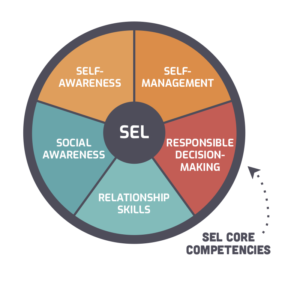
Self-Management
The ability to successfully regulate one’s emotions, thoughts, and behaviors in different situations — effectively managing stress, controlling impulses, and motivating oneself. The ability to set and work toward personal and academic goals.
- Impulse control
- Stress management
- Self-discipline
- Self-motivation
- Goal-setting
- Organizational skills
Social Awareness
The ability to take the perspective of and empathize with others, including those from diverse backgrounds and cultures. The ability to understand social and ethical norms for behavior and to recognize family, school, and community resources and supports.
- Perspective-taking
- Empathy
- Appreciating diversity
- Respect for others
Relationship Skills
The ability to establish and maintain healthy and rewarding relationships with diverse individuals and groups. The ability to communicate clearly, listen well, cooperate with others, resist inappropriate social pressure, negotiate conflict constructively, and seek and offer help when needed.
- Communication
- Social engagement
- Relationship-building
- Teamwork
Responsible Decision-Making
The ability to make constructive choices about personal behavior and social interactions based on ethical standards, safety concerns, and social norms. The realistic evaluation of consequences of various actions, and a consideration of the well-being of oneself and others.
- Identifying problems
- Analyzing situations
- Solving problems
- Evaluating
- Reflecting
- Ethical responsibility
Proven Effectiveness
Evidence-Based
A peer-reviewed study of CATCH My Breath found that students in schools that implemented the program were half as likely to experiment with e-cigarettes over the following 16 months, compared with those in schools that did not receive the program. The publication of the findings in Public Health Reports – the official journal of the U.S. Surgeon General – makes CATCH My Breath recognized as an evidence-based youth vaping prevention program. The study also found the program increased student knowledge of vaping dangers and positive perceptions about choosing a vape-free lifestyle.
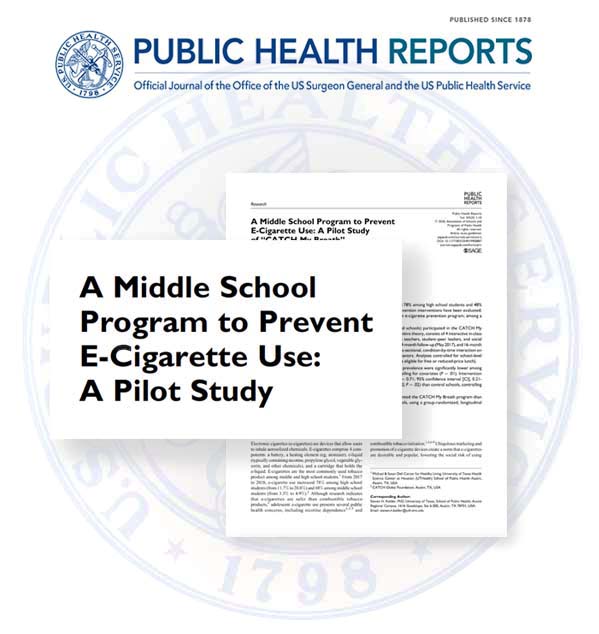
Program impact on an average middle school’s 7th grade class (192 students):

No Intervention
17 will try e-cigarettes if we do nothing.

Intervention: CATCH My Breath
8 would be prevented with CATCH My Breath.
SAMHSA-Recognized
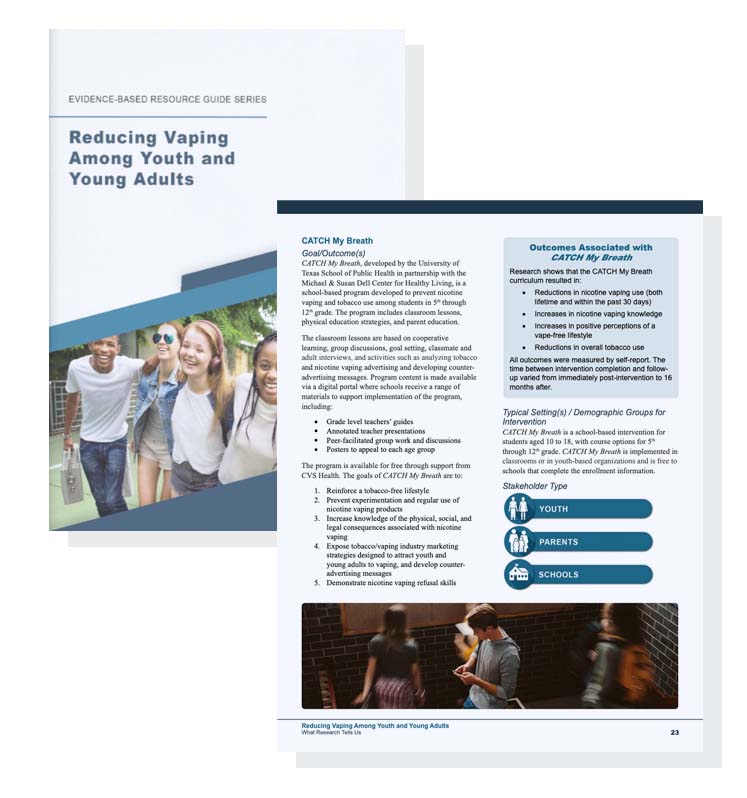
The Substance Abuse and Mental Health Services Administration (SAMHSA) recognized CATCH My Breath as the only recommended school-level youth vaping intervention in their Evidence-Based Resource Guide Series. SAMHSA noted that receiving training on CATCH My Breath was “vital” for successful implementation of the program and to build program capacity.
Want help developing a plan to use SAMHSA grant funds to implement tobacco youth prevention by CATCH My Breath in your community? Contact our program experts.
Community Tested
Chicago Public Schools
Chicago, IL
CATCH My Breath kicked off in Chicago Public Schools (CPS) during the 2017-2018 school year thanks to the grant from CVS Health Foundation. Starting with five schools reaching just over 1,000 students, the program diffused throughout the district by word […]
View SpotlightTexas
Statewide
CATCH My Breath was created in 2016 at The University of Texas School of Public Health (UTHealth) in Austin. Dr. Steven H. Kelder developed the curriculum as a response to the 900% spike in youth e-cigarette use from 2011-2015. The […]
View SpotlightSee All CATCH My Breath Spotlights

Get Started Schools & Organizations
Program Options
Contact us with any questions or for more information.
CATCH My Breath vaping prevention curriculum (FREE to U.S. SCHOOLS)
– Includes –
Free Program Supplements
Access includes English & Spanish versions of the core curriculum for grades 5-12.
Optional CATCH My Breath Add-Ons (Single Sign On Available for Districts)
Video Lessons ($99 / school)
Purchase
Live Implementation Training ($99 / seat)
Purchase
Live Train-the-Trainer Training ($425 / seat)
Purchase
Private Training
Inquire by email to [email protected]
Training Options
Implementation
Includes
Implementation
Includes
Event link information will be sent one business day prior to the session. Sessions will not be recorded. Should you not be able to attend a session, email [email protected] for alternative options.
Train-the-Trainer
Topics
Support Creates Impact
CATCH My Breath is the most-used youth nicotine vaping prevention program in the United States. The curriculum is offered free of cost to U.S. middle schools and high schools and has served over 1.8 million students across all 50 states in over 5,500+ schools.
To effectively scale our work and reach millions of children, CATCH My Breath relies on the generous support of our funding partners and donors, who help us bring full vape education program implementation and local capacity building services to the underserved communities who need it most.
Please contact us at [email protected] to learn more about sponsorship opportunities or how your company or foundation can help youth across the globe access vaping prevention education.

CATCH My Breath program usage in the U.S.
Used by Top Districts Nationwide
– Including –




Subscribe
Stay informed about the important issue of youth vaping prevention and stand with other parents, teachers, public health professionals, and concerned citizens working to combat the youth e-cigarette epidemic.
Donate Today






